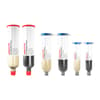LOCTITE ABLESTIK 968-4
Harmonization Code : 3506.10.00.00 | Prepared glues and other prepared adhesives, not elsewhere specified or included; products suitable for use as glues or adhesives, put up for retail sale as glues or adhesives, not exceeding a net weight of 1 kg
Main features
- Electrically Insulating
- B-Stageable
- Screen printable
Product Description
LOCTITE ABLESTIK 968-4 is a high-performance, heat-cure epoxy adhesive formulated for hybrid component attachment and lid sealing in critical electronic applications. Engineered for precision dispensing or screen printing, LOCTITE ABLESTIK 968-4 combines excellent electrical insulation, thermal conductivity, and mechanical strength to meet the stringent requirements of the electronics industry.
This adhesive is fully compliant with MIL-STD-883, Method 5011, ensuring performance under harsh conditions. Its B-stageable formulation simplifies assembly processes, making it suitable for high-reliability hybrid packages where controlled flow and precise application are essential.
Applications
- Hybrid component attachment
- Lid sealing for electronic modules and packages
- Screen printing or dispensing of adhesive in high-reliability electronics
- Applications requiring MIL-STD-883 compliance
Technical Specifications
| General Properties | |||||||||
| |||||||||
| Physical Properties | |||||||||
| Viscosity Viscosity Viscosity is a measurement of a fluid’s resistance to flow. Viscosity is commonly measured in centiPoise (cP). One cP is defined as the viscosity of water and all other viscosities are derived from this base. MPa is another common unit with a 1:1 conversion to cP. A product like honey would have a much higher viscosity -around 10,000 cPs- compared to water. As a result, honey would flow much slower out of a tipped glass than water would. The viscosity of a material can be decreased with an increase in temperature in order to better suit an application | 120000 mPa.s | ||||||||
| Chemical Properties | |||||||||
| |||||||||
| Water Extract Conductivity | 0.000025 Ohm | ||||||||
| Electrical Properties | |||||||||
| |||||||||
| Mechanical Properties | |||||||||
| |||||||||
| Thermal Properties | |||||||||
| |||||||||
| Glass Transition Temperature (Tg) Glass Transition Temperature (Tg) The glass transition temperature for organic adhesives is a temperature region where the polymers change from glassy and brittle to soft and rubbery. Increasing the temperature further continues the softening process as the viscosity drops too. Temperatures between the glass transition temperature and below the decomposition point of the adhesive are the best region for bonding. The glass-transition temperature Tg of a material characterizes the range of temperatures over which this glass transition occurs. | 167 °C | ||||||||
| Thermal Conductivity Thermal Conductivity Thermal conductivity describes the ability of a material to conduct heat. It is required by power packages in order to dissipate heat and maintain stable electrical performance. Thermal conductivity units are [W/(m K)] in the SI system and [Btu/(hr ft °F)] in the Imperial system. | 1 W/m.K | ||||||||
Additional Information
Recommended Curing Conditions
- 2 hours @ 150°C
Thawing:
- Allow container to reach room temperature before use.
- After removing from the freezer, set the syringes to stand vertically while thawing.
- DO NOT open the container before contents reach 25°C temperature. Any moisture that collects on the thawed container should be removed prior to opening the container.
- DO NOT re-freeze. Once thawed to 25°C, the adhesive should not be re-frozen.
Directions for Use
- Thawed adhesive should immediately be placed on dispense equipment for use.
- If the adhesive is transferred to a final dispensing reservoir, care must be exercised to avoid entrapment of contaminants and/or air into the adhesive.
- Adhesive must be completely used within the product's recommended work life.


.png)
.png)

